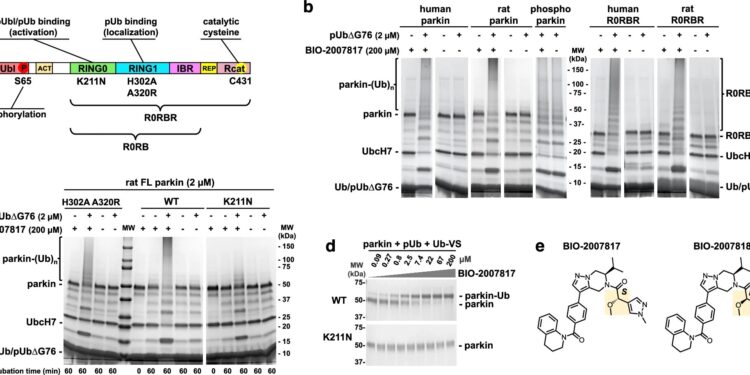Activation of parkin by tetrahydropyrazolopyrazine (THPP) BIO-2007817 in the presence of pUb. Credit: Nature Communications (2024). DOI: 10.1038/s41467-024-51889-3
More than 100,000 Canadians are currently living with Parkinson’s disease. A new drug molecule being studied by McGill University researchers could reactivate the cleaning functions of brain cells in young patients with the disease, opening the door to potential future treatments for this incurable degenerative disease.
“We are excited about this drug compound because it opens the possibility of a cure for Parkinson’s disease for a subset of patients,” said Kalle Gehring, professor of biochemistry at McGill University.
Developed by biotech company Biogen, the new compound has shown promising results by activating parkin, a key brain protein responsible for “cleaning up” and recycling damaged mitochondria. When parkin isn’t working properly, these damaged mitochondria accumulate, eventually leading to Parkinson’s disease.
In studies published in 2013 and 2018, Gehring shed light on parkin’s functions based on data collected at the Canadian Light Source (CLS) at the University of Saskatchewan (USask).
In this new follow-up study, Gehring used the CLS’s CMCF beamline to determine how Biogen’s compound activates parkin. They found that it binds parkin and a natural activator found in the cell. This molecular-level information is critical for future development of the drug.
“The drug molecule activates parkin through a secondary pathway, which is effective for specific parkin mutations that occur in younger patients,” he said.
After turning proteins into tiny crystals, Gehring and his team used a technique called protein crystallography to identify their 3D structures and discover where the new drug binds and how it affects the proteins. The results are published in the journal Nature Communications.
“We need quality data to solve protein structures and see their 3D images. We need a facility like the CLS to bring Canadian research to an international level,” said Gehring.
Although symptoms of Parkinson’s disease (slowed movement, tremors, and balance problems) often appear in people in their 60s, their onset at an earlier age is not uncommon, and 5 to 10 percent of people diagnosed are affected before the age of 40.
“We hope that one day we will find compounds that can treat Parkinson’s disease in general,” Gehring said. “As the Canadian population ages and better treatments for other diseases become available, neurodegenerative diseases like Parkinson’s will become a major health problem.”
While Gehring will continue to study parkin activation pathways as part of his ongoing research into the causes of Parkinson’s disease, it will be up to Biogen to apply the findings from this new study to future drug development, he said.
More information:
Véronique Sauvé et al, Activation of parkin by a molecular glue, Nature Communications (2024). DOI: 10.1038/s41467-024-51889-3
Provided by Canadian Light Source
Quote:New drug molecule could help treat Parkinson’s disease in young patients (2024, September 19) retrieved September 19, 2024 from
This document is subject to copyright. Apart from any fair dealing for the purpose of private study or research, no part may be reproduced without written permission. The content is provided for informational purposes only.



